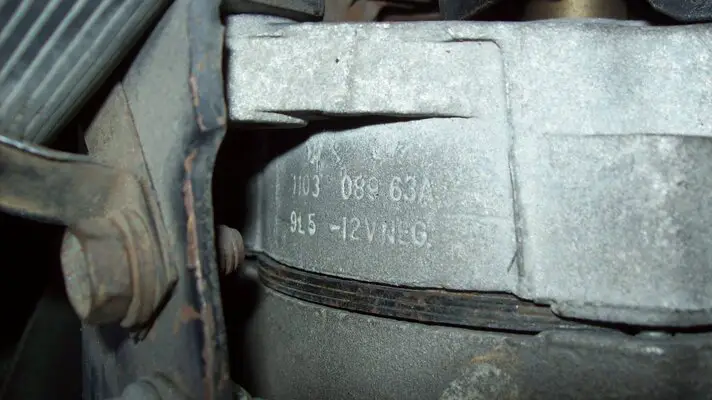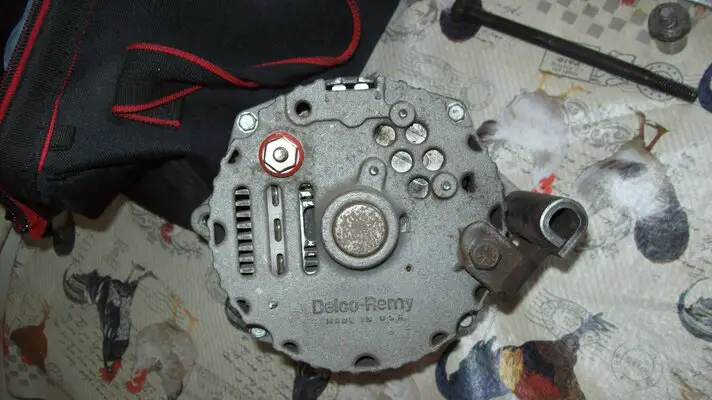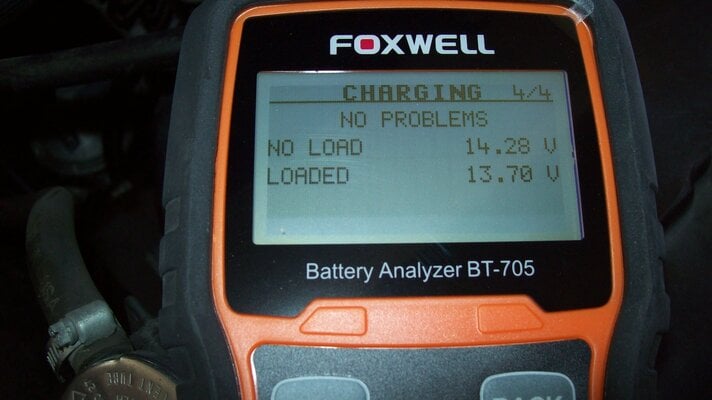Don't hold me to anything, but I also think that the 10si will use a sae bolt for the adjustment, where as the 12si will use metric. At least that's how any of them that I've dealt with have been.??? This is new. I have not heard of an 88 with a factory CS130. AFAIK, the 88 Cutlass RWD came with a 78A alternator, 12SI.
87 had a 1st and second design. 1st design was a carryover from the 84-86 p/n 1105565, 12SI. 2nd design was used in the last part of 1987 all the way to the end for the 88 models, p/n 1101303. Only difference I can discern between the two was they used different capacitor (for noise reduction) p/n and the screws that hold the front bearing retainer plate are different part numbers.
As for 12SI and 10SI, the 12SI has a ridge on the front of the frame end housing to fit behind the plastic fan for better air movement, as well as different and bigger intake vents in back. Many pieces CAN interchange, and some can't, but why would you? The 12SI makes more heat and needs better ventilation.
The big azz vents in the back and the big plastic fan are a dead giveaway for ID'ing the 12SI.
10SI to 12SI Alternator
- Thread starter Ernest
- Start date
You are using an out of date browser. It may not display this or other websites correctly.
You should upgrade or use an alternative browser.
You should upgrade or use an alternative browser.
Good point, and likely true. Pre-82, and some post-81 bolts are typically SAE. But you can't tell that if it's sitting on a bench just by looking at it. I was just going by whether you'd be going shopping for a 10SI or 12SI, to be able to look for quick references to ID what you're looking at from 5 feet away.Don't hold me to anything, but I also think that the 10si will use a sae bolt for the adjustment, where as the 12si will use metric. At least that's how any of them that I've dealt with have been.
What i though was a 61A alternator, is actually 63A, didnt catch the info on the case till after i removed it to have it checked locally.
Last pic... load test with my own tester, as instructed, no load, then loaded with headlights on high beam with blower fan on max speed(AC on), its a nice peice, i'd recomend it if you like informative, but simple.
Last pic... load test with my own tester, as instructed, no load, then loaded with headlights on high beam with blower fan on max speed(AC on), its a nice peice, i'd recomend it if you like informative, but simple.
Attachments
Last edited:
Your 1103089 alternator came off a 1980 car. Could be any of them calling for 63A (and usually with A/C) since they used that alternator up through 1982. The replacement number is 1979865.
The date code says it was built November 5, 1979.
Your alternator was pretty much the cat's meow...back in the 70s. 🙂
The date code says it was built November 5, 1979.
Your alternator was pretty much the cat's meow...back in the 70s. 🙂
For those that care, 60s-70s model GM alternators used an alpha-numeric date code with 3 or 4 digits.
Y=year
M=Month
D, or DD=day of the month. Typically, from day 1-9, they just used one digit. Sometimes they used two digits such as "06". Just depended on who was setting up the stamping machine.
For example: A date code of 8G27 = July 27,1968, or 1978. To determine the exact year may be difficult, but usually not impossible. Works great on original cars. Alternators and distributors, etc., were usually (not always) manufactured within a few months of the car's production date.
Month Codes:
A=Jan, B=Feb, C=March, D=April, E=May, F=June, G=July, H=Aug, J=Sept, K=Oct, L=Nov, M=Dec. (Note: the "I" is not used because it could be mistaken for a 1.)
You can sometimes rule out a year if you know they didn't make the part in that year. The 63A alternator you have could not have been made in 1989, although GM still reman'd them.
They seemed to use that code system for 1980-83, and used the numbers 1-9 for January through September. They used a letter code for October (O), November (N), and December (D). Followed by the 2 digit day date, and the single digit year code.
Month, Day, Year
Example: If your alternator was actually built on November 5, 1981, your date code would be N051.
And apparently, around the start of the 84 run, GM went back to the old code system. WTF?? Where they went back to the old month codes, but re-arranged the year back to the front.
Year, Month, Double digit day- again.
Example: If your alternator was originally built on November 5, 1989, your date code would likely be 9L05. So, basically the same date code on your 63A version. But since they stopped making/using 10SI on G-bodies by 1983...
Real world- 1983 H/O alternator date code of N093 November 9, 1982. And an 1985 442 original alternator. Built in February 1985. Alternator date stamp is 5A31, or January 31, 1985. Makes sense.

Barely readable but it says 5A31 under the part number.

And I know nobody asked for this, but see the attached Delco-Remy installation instructions pdf for alternators. It talks about re-clocking them as needed, too.
Y=year
M=Month
D, or DD=day of the month. Typically, from day 1-9, they just used one digit. Sometimes they used two digits such as "06". Just depended on who was setting up the stamping machine.
For example: A date code of 8G27 = July 27,1968, or 1978. To determine the exact year may be difficult, but usually not impossible. Works great on original cars. Alternators and distributors, etc., were usually (not always) manufactured within a few months of the car's production date.
Month Codes:
A=Jan, B=Feb, C=March, D=April, E=May, F=June, G=July, H=Aug, J=Sept, K=Oct, L=Nov, M=Dec. (Note: the "I" is not used because it could be mistaken for a 1.)
You can sometimes rule out a year if you know they didn't make the part in that year. The 63A alternator you have could not have been made in 1989, although GM still reman'd them.
They seemed to use that code system for 1980-83, and used the numbers 1-9 for January through September. They used a letter code for October (O), November (N), and December (D). Followed by the 2 digit day date, and the single digit year code.
Month, Day, Year
Example: If your alternator was actually built on November 5, 1981, your date code would be N051.
And apparently, around the start of the 84 run, GM went back to the old code system. WTF?? Where they went back to the old month codes, but re-arranged the year back to the front.
Year, Month, Double digit day- again.
Example: If your alternator was originally built on November 5, 1989, your date code would likely be 9L05. So, basically the same date code on your 63A version. But since they stopped making/using 10SI on G-bodies by 1983...
Real world- 1983 H/O alternator date code of N093 November 9, 1982. And an 1985 442 original alternator. Built in February 1985. Alternator date stamp is 5A31, or January 31, 1985. Makes sense.

Barely readable but it says 5A31 under the part number.

And I know nobody asked for this, but see the attached Delco-Remy installation instructions pdf for alternators. It talks about re-clocking them as needed, too.
Attachments
Wow that's a lot of knowledge! It seems from the discussion that I ought to go to the CS 130 105 Amp Olds unit.
My original alternator was a small 3 wire, using a stock battery for a 305 Base Coupe. Multi V belt System. That unit remains.
Since I have added.. fuel inj., high amp dual fans, a high-pressure fuel pump and HID high beams. I was Idling thru town in heavy rain with the A/C on one day, stopped for an errand, when I came out the Bat was LOW. I suppose the Alt couldn't keep up.
any thoughts?
My original alternator was a small 3 wire, using a stock battery for a 305 Base Coupe. Multi V belt System. That unit remains.
Since I have added.. fuel inj., high amp dual fans, a high-pressure fuel pump and HID high beams. I was Idling thru town in heavy rain with the A/C on one day, stopped for an errand, when I came out the Bat was LOW. I suppose the Alt couldn't keep up.
any thoughts?
One of the more practical reasons to upgrade to the CS style alternator is that they will charge at a lower RPM. Mine will actually bring the volt meter up at the 450 RPM that my engine idles at instead of having to rev up to 800-1000RPM before some of them switch on. Not that it is a big deal either way, but not having my lights dim down when I am at idle is worth it to me.I'm still of the firm belief that you don't need extra amps unless you need extra amps (huge electric fans, spotlight bar, giant stereo amps, etc.). 3-wire stock setups sense wtf is going on in the alternator, and the amps you need up to max output (which you can check with an ammeter and small screwdriver/shorting device). I doubt anyone's stock system will need 78/94 amps. GM replacement alternators for G-bodies got upgraded to 94 amps early on. Not because they were automatically better, it's because they already started making a slew of them that would bolt in the earlier models, thus reducing the amount of different parts. Bean-counters, ya know.
One-wire systems MAY not self-excite at idle. They usually will start working if you rev the engine, but if you just crank it up and don't give it revs, there's no guarantee it'll be charging right away.
The CS130 bolts right in. But compared to a 12SI, they're not cheap. The wiring would need an adapter, either one with a resistor in it or one without. Usually the warning bulb on the dash provides enough resistance, but maybe not. Then you'd need to get the resistor adapter. I admit, I'm not a wire biter, so I'm not going down that rabbit hole.
Think about this. Answer the question of why do you think you need a more powerful alternator like a CS130? The General invested millions of dollars on electrical system design/development and if they thought 78A was good enough, doubling it doesn't make any sense. Granted, if you plan on future upgrades, and you do put one of those whamodyne monster alternators on, and you can sleep better, go for it. But your car's stock electrical system doesn't need it. If it does, you're just band-aiding a problem elsewhere in the system.
If you're worried about that, put a smaller pulley on the alternator. Fixed.While looking up replacement alternators... i never thought to think about WHEN they start chargeing, as in what RPM they switch on, i idle my ZZ4 at 800rpm, so i'd like to get one that starts charging at a lower engine rpm.
One of the more practical reasons to upgrade to the CS style alternator is that they will charge at a lower RPM. Mine will actually bring the volt meter up at the 450 RPM that my engine idles at instead of having to rev up to 800-1000RPM before some of them switch on. Not that it is a big deal either way, but not having my lights dim down when I am at idle is worth it to me.
I was going to post that info myself. Also those aftermarket EFI kits are not the same grade as OEM. But
Similar threads
- Replies
- 9
- Views
- 362
- Replies
- 16
- Views
- 534
- Replies
- 0
- Views
- 184
- Replies
- 25
- Views
- 1K
GBodyForum is a participant in the Amazon Services LLC Associates Program, an affiliate advertising program designed to provide a means for sites to earn advertising fees by advertising and linking to amazon.com. Amazon, the Amazon logo, AmazonSupply, and the AmazonSupply logo are trademarks of Amazon.com, Inc. or its affiliates.




